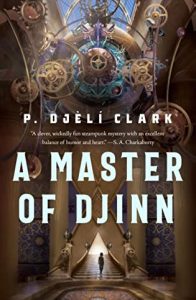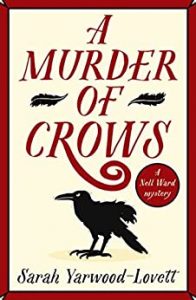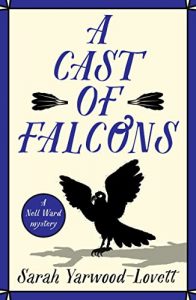 "One Man's Treasure" by Sarah Pinsker in Uncanny Magazine Issue 50, January-February 2023 by Sarah Pinsker
"One Man's Treasure" by Sarah Pinsker in Uncanny Magazine Issue 50, January-February 2023 by Sarah Pinsker Format: ebook
Source: supplied by publisher via Hugo Packet
Formats available: magazine, ebook
Genres: fantasy, short stories
Series: Uncanny Magazine Issue 50
Pages: 29
Published by Uncanny Magazine on January 3, 2023
Purchasing Info: Author's Website, Publisher's Website, Amazon, Barnes & Noble, Kobo
Goodreads
The January/February 2023 issue of Hugo Award-winning Uncanny Magazine .
Our landmark Issue 50, a double sized issue! Featuring new fiction by Ken Liu and Caroline M. Yoachim, Mary Robinette Kowal, P. Djèlí Clark, A. T. Greenblatt, A.M. Dellamonica, Eugenia Triantafyllou, Sarah Pinsker, E. Lily Yu, Marie Brennan, Christopher Caldwell, John Wiswell, and Maureen Mchugh. Essays by Elsa Sjunneson, John Picacio, Annalee Newitz, A.T. Greenblatt, Diana M. Pho, and Javier Grillo-Marxuach, poetry by Neil Gaiman, Terese Mason Pierre, Sonya Taaffe, Betsy Aoki, Theodora Goss, Ali Trota, Abu Bakr Sadiq, Elizabeth Bear, and Brandon O'Brien, interviews with Ken Liu and Caroline M. Yoachim by Tina Connolly; interviews with Eugenia Triantafyllou, E. Lily Yu, and Christopher Caldwell by Caroline M. Yoachim, a cover by Galen Dara, and editorials by Lynne M. Thomas and Michael Damian Thomas, and Meg Elison.
My Review:
This second entry in my very informal and scattered series of reviews of this year’s Hugo nominated works is focused on one of the nominees in the Novelette category – meaning a story between 7,500 and 17,500 words.
The title isn’t quite as evocative as last week’s “How to Raise a Kraken in Your Bathtub” – which is absolutely one of the most attention grabbing TITLES on the entire ballot. But this one came next because it’s from the same issue of Uncanny Magazine so I decided “Why not?”
For my next pick from the ballot I may have to resort to “Eeny, meeny, miny, moe” – or I will once I get through all the works by my faves that are on the list.
The title of this story, while not quite the claxon warning that Kraken should have been, does bring a scenario to the top of one’s mind – even if it’s a much different scenario – as well as a potentially less dangerous one.
“One man’s trash is another man’s treasure” as the old proverb goes. There’s also a variation about “one man’s meat being another man’s poison” but that’s not nearly as applicable in this story.
Because this is a story about the way that the trash gets taken out in a magically powered world, as seen through the eyes of the garbage collectors.
It’s kind of a “lower decks” story, in other words, a view of the world, not from the top where the movers and shakers do their moving and shaking and where stories are often set, but rather from much nearer to the bottom, where the nitty gritty is very gritty indeed and where shit gets done and disposed of – in this case one truckload at a time.
But this particular story is also a story about class and labor organizing and the rich being different from you and me, and especially from Aden, Blue and Nura.
And it’s a story about karma being a real bitch – but in a way that might just possibly teach someone a few lessons as she goes.
Escape Rating B-: It’s lucky for this story that it is not in the same category as Kraken because in spite of having potentially twice as much space to tell its tale, One Man’s Treasure doesn’t stick the dismount half as well.
The best part of One Man’s Treasure is the world creation and character creation by way of slice of life. On the one hand, it’s fantastically familiar on multiple levels.
While we might not think about how the Wizarding World in Harry Potter gets rid of its trash, it does have to happen somehow. In a magical world where everyone has a bit of magic, and a leisure class that has even more leisure, there would be neighborhoods where more magical detritus got thrown in the trash because there was more available to waste.
The potential of magical trash to be magically dangerous seems high once you think about it for a minute. That the ritzy neighborhoods would be paying good money to make sure that THEIR trash got taken away quietly and with minimal fuss seems obvious. That’s just humans being human in their ugliness.
The garbage collectors themselves, Aden and Blue along with Aden’s girlfriend Nura, represent an entirely different perspective. They’re the ones at the sharp end of the danger. They resent the waste of material and money that could make their lives better – AND they are frustrated by government budgeting – set by those very same rich people who don’t want to see them – that refuse to fund even basic safety equipment for their very dangerous jobs.
The situation is ripe for some kind of labor organizing and class action – which is exactly what happens. The way that situation comes about is woven into every thread of the story – even if the exact triggering point is a disgusting surprise.
But the denouement of the whole story felt a bit rushed, as though the words were running out – they possibly were – and it had to get wrapped. The character who has been lying all along – and for disgusting reasons – gets found out and gets punished. He seems to have an epiphany but we don’t get the chance to find out whether that’s real or whether it stuck.
So I was happily reading along, really liking the characters and loving the way the whole thing was working out and then BOOM it was over but not in a way that really felt like closure. This is a story where the world is terrifically built and just the right balance between familiar and new – but if you want to feel like it came to a solid conclusion you’ll need to decide that in your own head after you’ve finished – even as you wonder whether or not Aden ever lost the fox ears.

 The Bodies in the Library (First Edition Library Mystery, #1) by
The Bodies in the Library (First Edition Library Mystery, #1) by  The discovery of a body in the Society’s library, the morning after a contentious meeting of a local writers’ group, seems a bit too much like it’s straight out of the pages of one of the Agatha Christie novels sitting on a nearby shelf, The Body in the Library.
The discovery of a body in the Society’s library, the morning after a contentious meeting of a local writers’ group, seems a bit too much like it’s straight out of the pages of one of the Agatha Christie novels sitting on a nearby shelf, The Body in the Library. Speaking of media, however, the audio was fine, and it certainly got me over the rough first third of the book that drove me away the first time around. So I’m glad I picked it up – even though once the story finally got started I got more than caught up in it enough to want to find out whodunnit a whole lot faster than audio would allow.
Speaking of media, however, the audio was fine, and it certainly got me over the rough first third of the book that drove me away the first time around. So I’m glad I picked it up – even though once the story finally got started I got more than caught up in it enough to want to find out whodunnit a whole lot faster than audio would allow.


 Current Giveaways:
Current Giveaways: Blog Recap:
Blog Recap: Coming This Week:
Coming This Week:

















 "How to Raise a Kraken in Your Bathtub" by P. Djèlí Clark in Uncanny Magazine Issue 50, January-February 2023 by
"How to Raise a Kraken in Your Bathtub" by P. Djèlí Clark in Uncanny Magazine Issue 50, January-February 2023 by  As a person with at least a Supporting Membership in this year’s World Science Fiction Convention, I have voting rights for the Hugo Awards. In order to be informed about exercising those rights, the Awards committee compiles a packet of ebook versions of as much of the nominated material as the publishers will give them. That packet became available this week and I immediately downloaded the lot.
As a person with at least a Supporting Membership in this year’s World Science Fiction Convention, I have voting rights for the Hugo Awards. In order to be informed about exercising those rights, the Awards committee compiles a packet of ebook versions of as much of the nominated material as the publishers will give them. That packet became available this week and I immediately downloaded the lot. Lost Ark Dreaming by
Lost Ark Dreaming by  The Marlow Murder Club (Marlow Murder Club, #1) by
The Marlow Murder Club (Marlow Murder Club, #1) by  Recommended, pretty much everywhere as a readalike for
Recommended, pretty much everywhere as a readalike for  The other thing I really liked was that, while the local police were completely overwhelmed by a serial killer in their tiny town, the reasons they were overwhelmed were much easier to understand and empathize with than the lackluster performance of the local constabulary in
The other thing I really liked was that, while the local police were completely overwhelmed by a serial killer in their tiny town, the reasons they were overwhelmed were much easier to understand and empathize with than the lackluster performance of the local constabulary in  Dear Edna Sloane by
Dear Edna Sloane by  A Mischief of Rats by
A Mischief of Rats by  Whichever of her two personas is her alter ego, both of them are entirely too busy during the jam-packed weekend this story takes place.
Whichever of her two personas is her alter ego, both of them are entirely too busy during the jam-packed weekend this story takes place. Escape Rating B-: This third book in the
Escape Rating B-: This third book in the  I admit that this is a ‘me’ thing that may not be a ‘you’ thing. Howsomever, for this reader it feels like Nell’s romantic trials and tribulations are a bit over the top, particularly as her rich and aristocratic background – along with her surprisingly functional relationship with her parents – seem to have insulated her from a whole lot of regular stresses and issues to the point where over-the-top is the only direction left.
I admit that this is a ‘me’ thing that may not be a ‘you’ thing. Howsomever, for this reader it feels like Nell’s romantic trials and tribulations are a bit over the top, particularly as her rich and aristocratic background – along with her surprisingly functional relationship with her parents – seem to have insulated her from a whole lot of regular stresses and issues to the point where over-the-top is the only direction left.